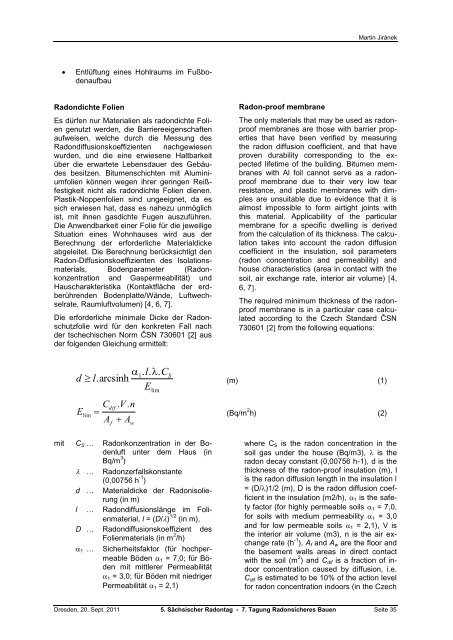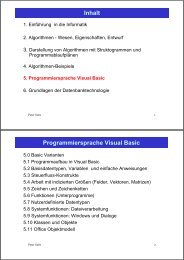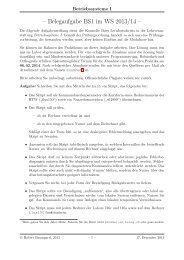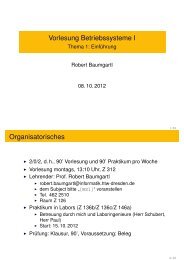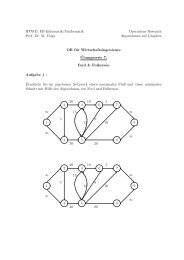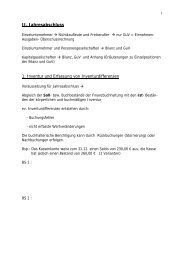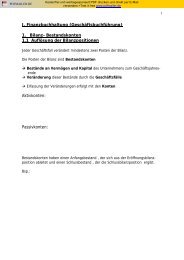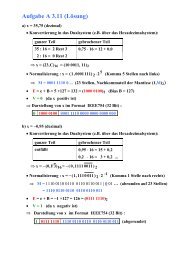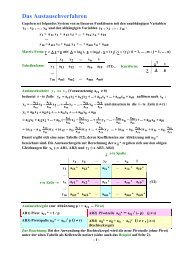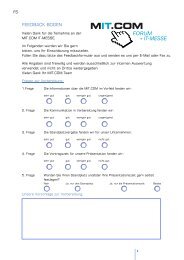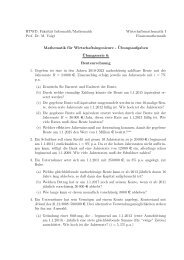5. sächsischer radontag - Hochschule für Technik und Wirtschaft ...
5. sächsischer radontag - Hochschule für Technik und Wirtschaft ...
5. sächsischer radontag - Hochschule für Technik und Wirtschaft ...
Erfolgreiche ePaper selbst erstellen
Machen Sie aus Ihren PDF Publikationen ein blätterbares Flipbook mit unserer einzigartigen Google optimierten e-Paper Software.
� Entlüftung eines Hohlraums im Fußbodenaufbau<br />
Radondichte Folien<br />
Es dürfen nur Materialien als radondichte Folien<br />
genutzt werden, die Barriereeigenschaften<br />
aufweisen, welche durch die Messung des<br />
Radondiffusionskoeffizienten nachgewiesen<br />
wurden, <strong>und</strong> die eine erwiesene Haltbarkeit<br />
über die erwartete Lebensdauer des Gebäudes<br />
besitzen. Bitumenschichten mit Aluminiumfolien<br />
können wegen ihrer geringen Reißfestigkeit<br />
nicht als radondichte Folien dienen.<br />
Plastik-Noppenfolien sind ungeeignet, da es<br />
sich erwiesen hat, dass es nahezu unmöglich<br />
ist, mit ihnen gasdichte Fugen auszuführen.<br />
Die Anwendbarkeit einer Folie <strong>für</strong> die jeweilige<br />
Situation eines Wohnhauses wird aus der<br />
Berechnung der erforderliche Materialdicke<br />
abgeleitet. Die Berechnung berücksichtigt den<br />
Radon-Diffusionskoeffizienten des Isolationsmaterials,<br />
Bodenparameter (Radonkonzentration<br />
and Gaspermeabilität) <strong>und</strong><br />
Hauscharakteristika (Kontaktfläche der erdberührenden<br />
Bodenplatte/Wände, Luftwechselrate,<br />
Raumluftvolumen) [4, 6, 7].<br />
Die erforderliche minimale Dicke der Radonschutzfolie<br />
wird <strong>für</strong> den konkreten Fall nach<br />
der tschechischen Norm ČSN 730601 [2] aus<br />
der folgenden Gleichung ermittelt:<br />
�1. l. �.<br />
C<br />
d � l.arcsinh<br />
E<br />
E<br />
lim<br />
Cdif . V. n<br />
�<br />
A � A<br />
f w<br />
lim<br />
mit CS … Radonkonzentration in der Bodenluft<br />
unter dem Haus (in<br />
Bq/m 3 )<br />
� … Radonzerfallskonstante<br />
(0,00756 h -1 )<br />
d … Materialdicke der Radonisolierung<br />
(in m)<br />
l … Radondiffusionslänge im Folienmaterial,<br />
l = (D/�) 1/2 (in m),<br />
D … Radondiffusionskoeffizient des<br />
Folienmaterials (in m 2 /h)<br />
�1 … Sicherheitsfaktor (<strong>für</strong> hochpermeable<br />
Böden �1 = 7,0; <strong>für</strong> Böden<br />
mit mittlerer Permeabilität<br />
�1 = 3,0; <strong>für</strong> Böden mit niedriger<br />
Permeabilität �1 = 2,1)<br />
S<br />
Radon-proof membrane<br />
Martin Jiránek<br />
The only materials that may be used as radonproof<br />
membranes are those with barrier properties<br />
that have been verified by measuring<br />
the radon diffusion coefficient, and that have<br />
proven durability corresponding to the expected<br />
lifetime of the building. Bitumen membranes<br />
with Al foil cannot serve as a radonproof<br />
membrane due to their very low tear<br />
resistance, and plastic membranes with dimples<br />
are unsuitable due to evidence that it is<br />
almost impossible to form airtight joints with<br />
this material. Applicability of the particular<br />
membrane for a specific dwelling is derived<br />
from the calculation of its thickness. The calculation<br />
takes into account the radon diffusion<br />
coefficient in the insulation, soil parameters<br />
(radon concentration and permeability) and<br />
house characteristics (area in contact with the<br />
soil, air exchange rate, interior air volume) �4,<br />
6, 7�.<br />
The required minimum thickness of the radonproof<br />
membrane is in a particular case calculated<br />
according to the Czech Standard ČSN<br />
730601 �2� from the following equations:<br />
(m) (1)<br />
(Bq/m 2 h) (2)<br />
where CS is the radon concentration in the<br />
soil gas <strong>und</strong>er the house (Bq/m3), � is the<br />
radon decay constant (0,00756 h-1), d is the<br />
thickness of the radon-proof insulation (m), l<br />
is the radon diffusion length in the insulation l<br />
= (D/�)1/2 (m), D is the radon diffusion coefficient<br />
in the insulation (m2/h), �1 is the safety<br />
factor (for highly permeable soils �1 = 7,0,<br />
for soils with medium permeability �1 = 3,0<br />
and for low permeable soils �1 = 2,1), V is<br />
the interior air volume (m3), n is the air exchange<br />
rate (h -1 ), Af and Aw are the floor and<br />
the basement walls areas in direct contact<br />
with the soil (m 2 ) and Cdif is a fraction of indoor<br />
concentration caused by diffusion, i.e.<br />
Cdif is estimated to be 10% of the action level<br />
for radon concentration indoors (in the Czech<br />
Dresden, 20. Sept. 2011 <strong>5.</strong> Sächsischer Radontag - 7. Tagung Radonsicheres Bauen Seite 35


